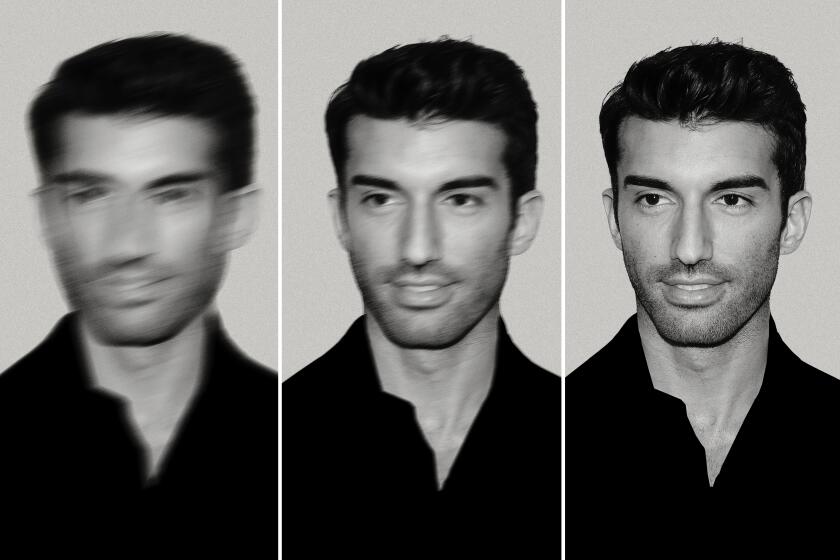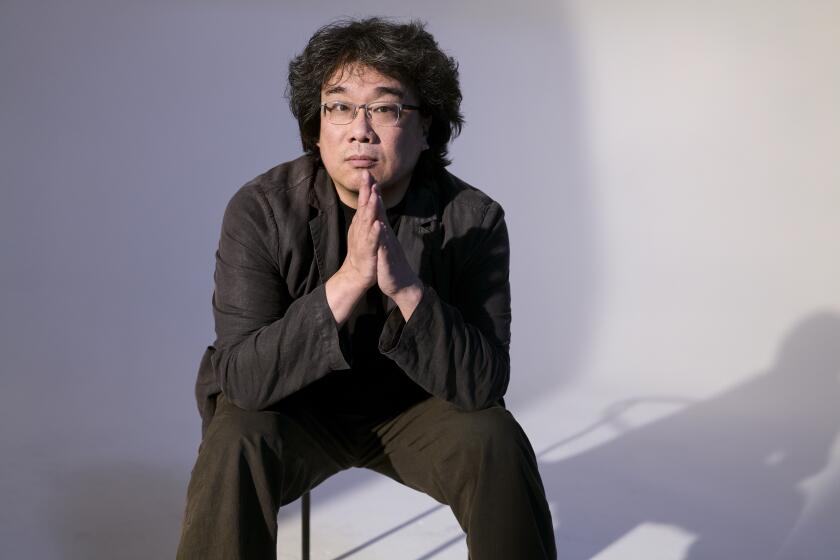It’s Still a Guy Thing: The Evolution of Buddy Movies
- Share via
There are probably a thousand reasons why buddy pictures are the most enduring genre in Hollywood, but if you ask Barry Levinson, there’s one simple explanation: “It’s amazing how different things are when guys are with guys and when guys are with women.”
At 59, Levinson is one of moviedom’s leading authorities on the venerable art of male bickering and bonding, which the veteran director has eloquently explored in such films as “Diner” and “Tin Men.” His latest take on the subject, “Bandits,” due out Friday, stars Bruce Willis and Billy Bob Thornton as a pair of squabbling bank robbers who fall for a madcap housewife, played by Cate Blanchett, who turns their lives doubly upside-down (as Vanity Fair put it--think “Jules and Jim” on the lam).
Westerns are dead. Detective movies are gone. Screwball comedies are kaput. But buddy films are still alive and well. In fact, they’re so modern that when one of the producers of “The Wash,” an upcoming comedy starring Dr. Dre and Snoop Dogg, was asked to give a shorthand description of the film, he said: Imagine a hip-hop version of “The Odd Couple.” The year’s second-highest grossing film is “Rush Hour 2,” a Jackie Chan-Chris Tucker buddy picture sequel that just passed the $220-million mark. “Training Day,” another new film with a buddy twist--gangsta cop terrorizes wide-eyed police recruit--just opened No. 1 at the box-office last weekend. The two men in “Bandits” have a similarly fractious relationship. Thornton is the obnoxious comic chatterbox, Willis the long-suffering strongman. When the two men are holed up in a garage, evading the police, Thornton starts snorting, trying to clear his sinuses. Willis stares at his partner, a half-smile flickering across his face. Seeing this moment of intimacy between the two actors, you realize you could be watching any of the great male marriages of the past, be it Bob Hope and Bing Crosby, Paul Newman and Robert Redford or Walter Matthau and Jack Lemmon. After all, it was Matthau who said to Lemmon in “The Odd Couple”: “I can’t take it anymore. Everything you do irritates me. And when you’re not here, the things I know you’re gonna do when you come in irritate me.”
Buddy films come in 57 varieties--the genre is elastic enough to include everything from “Some Like It Hot” and “The Man Who Would Be King” to “Easy Rider” and “Swingers”--but they are essentially fables about the foibles of the male species. What the buddy picture really represents is the all-male romantic comedy.
Whatever the film, the premise is the same: two wildly different men are thrown together, their relationship tested by events until they discover an unlikely affinity, forging a bond of friendship that replaces the customary guy-gal sexual union at picture’s end. In “The Odd Couple,” its male leads even settle into husband-and-wife domesticity, with Oscar Madison as the sloppy grouch, Felix Ungar as the fussy homemaker.
In many ways, the buddy film serves as a necessary escapist fantasy; it’s one of the few arenas where men can openly express their feelings for each other, even though men on screen today seem less comfortable with each other than ever before. The men in ‘30’s films, especially those directed by Howard Hawks, are far less inhibited than the action heroes of today. Most of the men in ‘90s buddy films smother their affection for each other in wisecracks. One reason Sidney Lumet’s 1975 film “Dog Day Afternoon” remains fresh today is that it tossed out the subtext--it’s about two men openly in love with each other.
Buddy pictures have always been a man’s, man’s world. Try to compile a list of female-driven buddy pictures: After you jot down “Thelma and Louise,” you may need to call Leonard Maltin to come up with more examples.
The point: In buddy films, freed from confronting the sticky complexity of sex, men are allowed to debate the important things in life, like the easiest way to rob a bank.
“I find that most arguments between men and women can digress into other things very quickly, especially when there’s sex involved,” explains George Gallo, who wrote “Midnight Run,” the 1988 Robert De Niro-Charles Grodin film that’s a classic of the genre. “Men in general forgive verbal abuse a lot easier, maybe because we attack each other in a very focused way. I can say some pretty horrible things to a guy and then 20 minutes later go off and have a beer together. But when a woman’s involved, it gets a lot more complicated. Let’s face it, they’re talking a different language than we are.”
There’s something quintessentially American about male bonding. It flourished long before movies were even invented, dating at least as far back as Mark Twain, who created two pivotal buddy archetypes: Huck Finn and Tom Sawyer, the original good boy-bad boy combo, as well as Huck and runaway slave Jim, whose complex relationship is at the heart of “Huckleberry Finn” and predates the interracial pairings of films such as “48 Hours” by a century.
In the early 20th century, buddy teams became a staple of early vaudeville acts. By the 1930s, films were full of comedy duos, first with Laurel and Hardy, then Abbott and Costello and others.
The formula has been renewed ever since: Hope and Crosby in the ‘40s, Dean Martin and Jerry Lewis in the ‘50s, Matthau and Lemmon in the ‘60s, Richard Pryor and Gene Wilder in the late ‘70s, Eddie Murphy and Nick Nolte in the 1980s.
“It’s a very American thing,” says film historian David Thomson. “There are very few buddy movies in British or French films. You just wouldn’t see three Englishmen behave the way American men do, who are truly happiest when they are together with other men.”
The key to buddy movies is chemistry that derives from opposites that attract. It’s why so many modern-day buddy films pair up black and white actors--the stark contrasts in racial style give the movies an extra kick.
In most buddy films, the comedy comes from pure aggravation. In “Silver Streak,” Pryor is infuriated by Wilder’s honky haplessness. In “The In-Laws,” Peter Falk thrives on keeping Alan Arkin in a perpetual panic. In the “Rush Hour” films, Tucker and Chan literally speak different languages. Director Brett Ratner says that when the two actors met, they both said they didn’t understand a word their co-star said.
“That’s when I knew they’d be perfect together,” Ratner says. “The chemistry comes from how they respond to each other. When we put Chris and Jackie together, it was like an explosion in a bottle.”
Ratner calls it chemistry. Gallo calls it “the yin-yang thing.” For Levinson on “Bandits,” it came down to casting. “With buddy movies, you always want some kind of conflict,” he says. “In ‘Bandits,’ Bruce is the great straight man, feeding Billy Bob. It’s almost like Martin and Lewis, with one guy setting the other guy up. Without Bruce playing it so straight and setting Billy Bob up, we’d have no contrast, Billy Bob wouldn’t have anyone to bounce off of.”
Many of the best buddy films spring into high gear when the filmmaker introduces a dramatic irritant, usually in the form of a beautiful, free-spirited woman who sparks the flame of romantic conflict. Could you possibly imagine the Hope-Crosby road movies without Dorothy Lamour? “Some Like It Hot” without Marilyn Monroe? After Blanchett turns up in “Bandits,” Willis and Thornton debate what to do with her, with Thornton lobbying for shooting her and burying her body in the woods. From the back seat, Blanchett complains: “What am I, invisible?” Of course not. The men are already fighting over her.
Buddy movies tell a lot about men, but they also tell us a lot about the eras the films come from. The Hope-Crosby films are wartime escapist fantasies. The ‘70s buddy films are steeped in paranoia and alienation, whether it’s “Scarecrow,” with Al Pacino and Gene Hackman as hitchhiking losers, or “All the President’s Men,” which teams Dustin Hoffman and Redford in a political thriller. Even today’s bland action comedies make a point. If nothing else, the “Rush Hour” films are an apt symbol of our new colorblind pop sensibility--you’d better believe studio chiefs noticed that a film topped the $220-million mark without a white actor on the marquee.
*
“The Big Picture” runs Tuesdays in Calendar. If you have questions, ideas or criticism, e-mail them to patrick.goldstein@latimes.com.
More to Read
Only good movies
Get the Indie Focus newsletter, Mark Olsen's weekly guide to the world of cinema.
You may occasionally receive promotional content from the Los Angeles Times.










